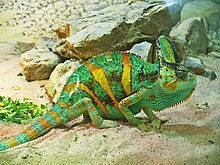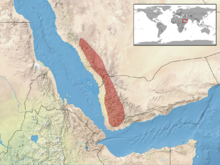Chamaeleo calyptratus
| Veiled chameleon | |
|---|---|
 |
|
| Scientific classification | |
| Kingdom: | Animalia |
| Phylum: | Chordata |
| Class: | Reptilia |
| Order: | Squamata |
| Suborder: | Iguania |
| Family: | Chamaeleonidae |
| Genus: | Chamaeleo |
| Species: | C. calyptratus |
| Binomial name | |
|
Chamaeleo calyptratus Duméril & Bibron, 1851 |
|
 |
|
The veiled chameleon (Chamaeleo calyptratus) is a species of chameleon native to the Arabian Peninsula in Yemen and Saudi Arabia. Other common names include cone-head chameleon and Yemen chameleon.
The male is 43 to 61 cm (17 to 24 in) long from the snout to the tip of the tail. The female is shorter, no more than about 35 cm (14 in), but it has a thicker body. Both sexes have a casque on the head which grows larger as the chameleon matures, reaching about 5 cm (2.0 in) in the largest adults. Newly hatched young are pastel green in color and develop stripes as they grow. Adult females are green with white, orange, yellow, or tan mottling. Adult males are brighter with more defined bands of yellow or blue and some mottling.
Coloration can be affected by several factors, including social status. In experimental conditions, young veiled chameleons reared in isolation are darker and duller in color than those raised with other individuals. Females change color across their reproductive cycles. Chameleons also tend to change to a much darker color when stressed.
This chameleon lives in a number of habitat types in its native range, including plateaus, mountains, and valleys. Like other chameleons, it is arboreal, living in trees and other large plants. It prefers warmer temperatures, generally between 24 to 35 °C (75 to 95 °F).
The veiled chameleon is an omnivore. It favors insects, and it also eats plant matter, especially as a source of water.
The life span is about 5 years for females, and up to 8 years for males. They reach sexual maturity at four to five months. They breed more than once a year. The female lays large clutches of up to 85 eggs and buries them in sand. The eggs are white with a tough skin. The embryos experience a diapause, a length of time when they are dormant in the egg before they begin developing. Increasing temperatures in the substrate initiate development.
Males display for females during courtship, performing behaviors such as "head rolls" and "chin rubs". Females change color when they are receptive to breeding, and males are more likely to court them during this time.
The veiled chameleon is the most common Chamaeleo species in the pet trade. It is easy to breed and prolific in its egg production. It tolerates a range of conditions and survives well in captivity.
...
Wikipedia

